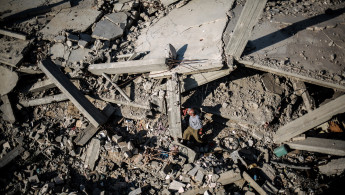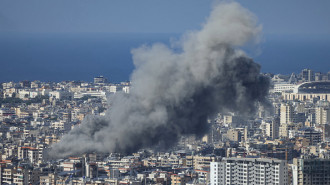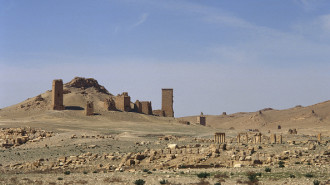Over two million lives in Gaza suffer from 16-year-long Israeli blockade: OCHA
Despite the slight easing witnessed by the residents of Gaza, the impoverished coastal enclave still suffers from negative consequences of the 16-year-long Israeli and Egyptian imposed blockade, according to the United Nations Office for the Coordination of Humanitarian Affairs (OCHA).
OCHA said in a newly released report that "the longstanding restrictions on the movement of people and goods to and from Gaza have undermined the living conditions of over two million Palestinian residents."
"Israel continues to reduce access to livelihoods, essential services, and housing, disrupt family life, and undermine people's hopes for a secure and prosperous future (...) the situation has been compounded by the restrictions imposed by the Egyptian authorities at the Rafah crossing," OCHA's report added.
Since 2007, Israel has imposed its illegally tightened blockade on the Gaza Strip, home to more than 2.3 million people, after the Islamic Hamas movement, which won the legislative elections in 2006.
Moreover, it launched five large-scale military wars against the population, killing and wounding thousands of Gazans and destroying most of the local official and civilian facilities as well as the frustration.
What worsened the situation was the imposing of another blockade on the ability of Gaza's residents to move in and out of the coastal enclave by the Egyptian authorities, under the pretext of curbing Hamas' empowerment.
The Hamas-run Interior Ministry said recently that the population of the impoverished coastal enclave has reached 2,375,259 million people by the end of 2022, and most are suffering consequences from the 'illegal' Israeli blockade. https://t.co/vDB6qoTUak
— The New Arab (@The_NewArab) January 10, 2023
For years, most of the Palestinians in Gaza were prevented by Israel and Egypt from leaving the territory.
However, both of these states resumed passage through their borders after reaching understanding with Hamas on various occasions, mainly at end of the wars between Israel and the armed Palestinian factions in Gaza.
"In last December, the Israel-controlled Erez crossing in the north of Gaza, about 45,640 Gazans were allowed by the Israeli authorities to reach either the West Bank or the Israeli territories to work or even receive their treatment," OCHA's report noted.
"This was the highest number of exits on record since early 2000 (...) it was more than six times higher than the monthly average in 2021 but only 9 per cent of the monthly average in 2000, before imposing the Israeli blockade," OCHA added.
About 87 per cent of the exits were by Palestinians allowed out under permits in the category for 'traders' and 'economic needs', most of whom are employed as day labourers in Israel, while nine per cent of the exits were by patients referred for medical treatment in the West Bank or Israel and their companions, according to the report.
The report further notes that the Egyptian authorities allowed 13,270 Gazans passage through Rafah crossing in December 2022. It was slightly higher than the number of exits in November and 58 per cent more than the monthly average in 2021 following ending the COVID-19 restrictions.
Since the imposition of the blockade in 2007, Israeli authorities restricted the entry into Gaza of goods under the pretext that they would have dual [civilian and military] use such as building materials, certain medical equipment, and some agricultural items.
However, Israel recently allowed cement and steel bars to enter the coastal enclave through the only Israeli-controlled commercial crossing of Kerem Shalom following a lengthy application and review process.
Since 2018, goods from Egypt also entered Gaza regularly via the Rafah crossing, controlled by the Egyptian authorities, and then through the adjacent Salah Ad Din Gate, controlled by the local authorities.
In December, 10,210 truckloads of authorised goods entered Gaza, 5 per cent below the previous month and 29 per cent more than the monthly average in 2021.
Still, this was 9 per cent lower than the monthly average on the eve of the blockade in 2007, although Gaza's population has grown by more than 55 per cent since then.
Of the goods entered, 46 per cent were construction materials, and 29 per cent were food supplies. About 3 per cent were humanitarian aid facilitated by international organisations, including food and medical supplies.
In turn, about 725 truckloads of authorised goods exited Gaza, 40 per cent more than the previous month and 91 per cent more than the monthly average in 2021.
The Israeli authorities lifted a ban, imposed between 7 November and 26 December, on the transfer of fresh fish to the West Bank, allowing the exit of 10 tons (3 truckloads). However, they reduced the quota from 20 tons to 10 tons per week.
Overall the Israeli authorities allowed the exit of 577 truckloads of authorised goods, 39 per cent more than in the previous month. Still, this was 40 per cent below the monthly average on the eve of the blockade in 2007.
About 71 per cent of the outgoing goods went to the West Bank, 29 per cent was exported to Israel, and less than 1 per cent was shipped abroad. Vegetables accounted for 60 per cent of exports, strawberries 24 per cent, and textiles 8 per cent, while the remainder included furniture, aluminium scrap, used copper, furniture, and fish.
Another 148 truckloads were exported to Egypt, carrying scrap iron and used batteries. This is 43 per cent lower than in the previous month.
In 2022, Egypt authorised only four commodities to exit through its border: scrap batteries, iron scrap, aluminium scrap, and copper scrap.
"It is not possible to rely on some of the facilities provided by Israel to the Gaza Strip or even talk about providing humanitarian facilities for the local population, especially since the population has doubled in recent years and they need a final lifting of the Israeli blockade," Gaza-based political expert Hussam al-Dajany said to The New Arab.
"Gaza Strip needs many years for its reconstruction, not only about infrastructure but also economic and political construction and the formation of a strong Palestinian entity capable of building a secure future for its residents," he said.
"Unfortunately," he added, "we are still under Israeli occupation, and we are still hostages to its arbitrary and criminal policies, which may herald more military escalation with Israel."




 Follow the Middle East's top stories in English at The New Arab on Google News
Follow the Middle East's top stories in English at The New Arab on Google News


![A group of Palestinians, foreign and Israeli activists gather to participated in an olive picking event on the land in the town of Battir, which is under threat of confiscation by Israel in Bethlehem, occupied West Bank on 8 November 2024. [Getty]](/sites/default/files/styles/image_330x185/public/2182930803.jpeg?h=199d8c1f&itok=__0LgGsa)